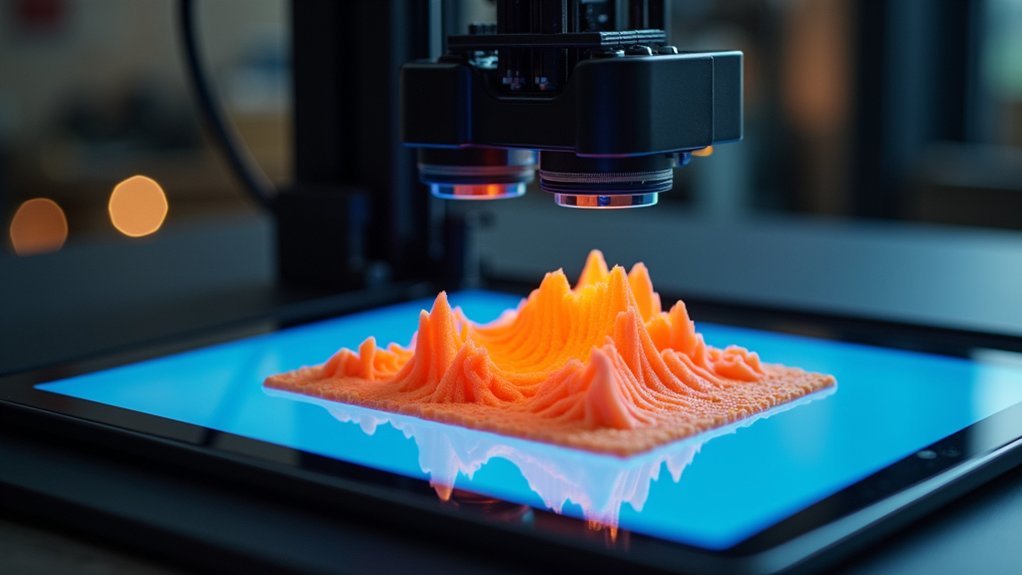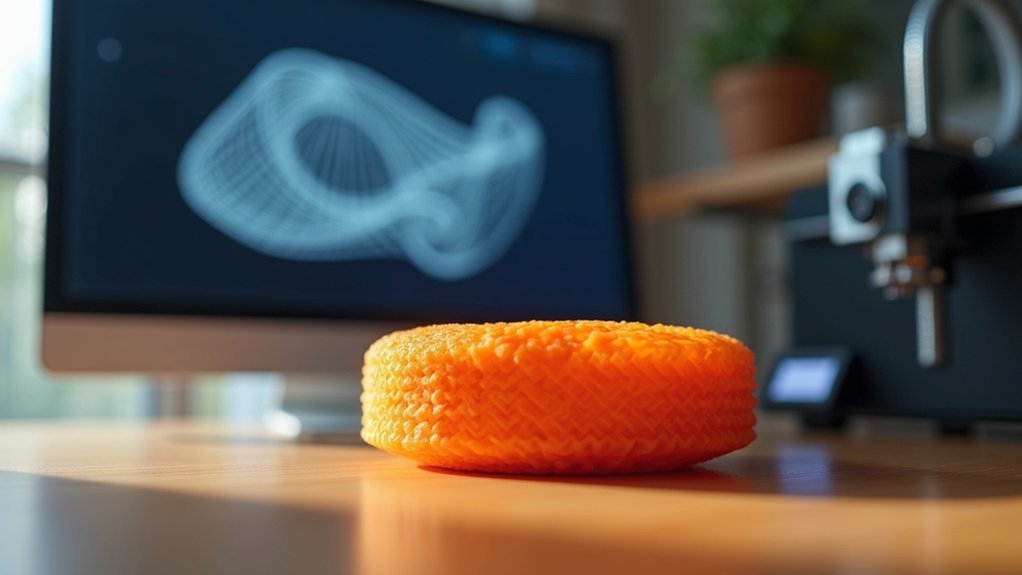Your STL file’s print-readiness depends on having clean triangular mesh geometry with no gaps, holes, or overlapping surfaces. You’ll need manifold geometry where each edge connects to exactly two triangles, proper outward-facing normals, and appropriate resolution settings. Set your chordal tolerance to 0.1mm and angular tolerance to 1 degree for ideal detail without excessive file size. Clean geometry guarantees your slicer can generate reliable G-code and prevents print failures during production.
Understanding STL File Structure and Geometry

When you examine an STL file, you’ll discover it represents your 3D model through a mesh of interconnected triangles that form the object’s surface geometry.
The STL file format uses three vertices and a normal vector to define each triangle within these triangular meshes. For your model to achieve print-ready format status, you’ll need proper manifold geometry where each triangle edge connects to exactly two adjacent triangles.
Your dimensional accuracy depends on key STL export parameters. Chordal tolerance controls how closely the mesh follows curved surfaces, while angular tolerance determines detail capture in complex geometries.
You’ll find that smaller tolerance values create more triangles, producing an accurate model with smoother surfaces but larger file sizes. Understanding these fundamentals guarantees your 3D printing projects start with ideal geometry.
Optimal Export Settings for Print Quality
Since your STL file’s export settings directly impact your final print quality, you’ll want to configure specific parameters that balance detail with manageable file sizes. Set your chordal tolerance/deviation to 0.1 mm (0.004 in) for best results. This guarantees your STL files used for 3D printing maintain sufficient detail without creating unnecessarily large files.
Your angular tolerance/deviation should be 1 degree to preserve small angular features accurately. Additionally, set a minimum triangle side length of 0.1 mm to enhance model detail while keeping files manageable.
When configuring your export settings, prioritize these key factors:
- Choose binary STL format over ASCII for reduced file size and faster processing
- Monitor file size—if it exceeds 20 MB, adjust tolerances accordingly
- Balance detail preservation with printing performance requirements
Resolution Balance Between Accuracy and File Size

While higher resolution STL files produce superior print quality through smaller triangles that better approximate curved surfaces, they’ll also generate considerably larger file sizes that can bog down your workflow.
| Resolution Level | Chordal Deviation |
|---|---|
| Low | 1/5th layer thickness |
| Medium | 1/10th layer thickness |
| High | 1/20th layer thickness |
| Ultra | 1/40th layer thickness |
You’ll want to target approximately 1/20th of your printer’s layer thickness for chordal deviation to achieve ideal balance between accuracy and file size. Keep STL files under 20 MB whenever possible to maintain reasonable slicing times. Low-resolution files create visible flat spots on curves, while excessively high resolution unnecessarily complicates printing. Finding the sweet spot guarantees your files deliver excellent print quality without overwhelming your system’s processing capabilities.
Mesh Quality and Manifold Geometry Requirements
Beyond achieving the right resolution settings, your STL files must meet strict geometric requirements to print successfully.
Manifold geometry guarantees each triangle edge connects to exactly two other triangles, creating a closed mesh that represents a solid volume. Without this structure, you’ll encounter printing errors when your slicer software can’t interpret the model properly.
Your mesh quality directly impacts print success. Here’s what you need to verify:
- No holes or gaps – Every surface must be completely closed
- Zero self-intersecting triangles – Overlapping geometry confuses slicers
- Proper triangle orientation – All normals should face outward consistently
Use CAD software tools to analyze and repair your STL files before printing.
These checks transform problematic meshes into print-ready files that’ll slice cleanly and print without complications.
Software Compatibility and Processing Efficiency

When you’re working with STL files, you’ll discover they offer unmatched compatibility across virtually every 3D modeling and slicing application available today. This software compatibility makes STL the industry standard for 3D printing workflows.
You’ll experience superior processing efficiency because STL files contain only geometric data, eliminating unnecessary complexity that slows down your projects.
Your slicer programs like Cura and PrusaSlicer can rapidly convert STL files into G-code with minimal computational overhead. This streamlined approach accelerates your rapid prototyping cycles considerably.
STL files enable lightning-fast G-code conversion in modern slicing software, dramatically reducing processing time and boosting your prototyping workflow efficiency.
However, you must verify your STL files are manifold and error-free before processing. Clean geometry translates directly to enhanced print reliability, reducing your risk of print failures and wasted materials during production.
Triangular Tessellation and Surface Approximation
Understanding how STL files construct 3D surfaces reveals why they’ve become the backbone of 3D printing technology. Your STL files use triangular tessellation to create geometric representation of complex shapes, where countless small triangles approximate curved surfaces through strategic positioning.
Achieving print-ready files requires balancing three critical factors:
- Resolution: Higher triangle counts create smoother surface approximation but increase file size
- Manifold geometry: Every edge must connect exactly two triangles for proper 3D printing
- Chordal deviation: Set to 1/20th of your printer’s layer thickness for peak quality
You’ll find that proper triangular tessellation directly impacts your print’s success. Too few triangles create faceted surfaces, while excessive triangulation unnecessarily bloats file size without improving print quality, making strategic mesh optimization essential for efficient processing.
File Format Advantages for 3D Printing Workflows
STL files dominate 3D printing workflows because they deliver universal compatibility across virtually every printer and slicing software on the market.
You’ll find this file format works seamlessly across different CAD programs, making collaboration effortless when sharing your model with teammates or manufacturers.
The format’s focus on surface geometry through triangular meshes guarantees your slicing software processes files quickly, dramatically reducing preparation time for additive manufacturing projects.
You can achieve precise resolution control by adjusting triangle density during export, balancing file size with print quality.
Since STL files contain only essential geometric data without colors or textures, your printing software handles them efficiently, allowing faster iteration cycles during prototyping and design validation phases.
Frequently Asked Questions
Are STL Files Ready to Print?
STL files aren’t automatically print-ready. You’ll need to verify they’re manifold with no holes, use proper export tolerances, check for adequate triangle mesh quality, and guarantee reasonable file sizes before printing successfully.
What Makes a File Print Ready?
You’ll need a manifold mesh without gaps or holes, proper resolution balancing detail and file size, correct export tolerances, no intersecting geometry, and smooth surfaces free from unwanted flat spots.
How to Prepare STL for Printing?
You’ll need to verify your STL’s manifold, set proper tolerances, eliminate flat spots, export in binary format, then use slicer software to convert it into G-code for your printer.
How to Make Model 3D Print Ready?
You’ll need to guarantee your model’s manifold with proper wall thickness, fix mesh errors like holes or inverted normals, optimize triangle counts, and verify structural integrity before exporting to STL format.





Leave a Reply